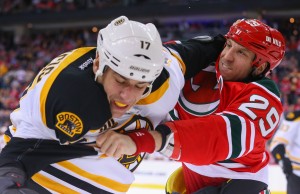The role of the NHL enforcer is one which has come under scrutiny in the past several years. When the Toronto Maple Leafs began the season without an enforcer after cutting Colton Orr and Frazer McLaren, many began to sense the start of a transition away from tough guys in the league. The move also made people question the role of enforcers, and whether its effectiveness is beginning to decline.
How effective have enforces and tough guys been in the past? Have they been used merely as energy players and defend star players, or have they also been used to produce offensively? Perhaps some math can help paint a picture.
If we look up the ten players who had the highest penalty minutes (PIM) of each year from the 1970-1971 season to the 2011-2012 season (courtesy of hockeydb.com), then look at their points for each player, we can come up with the ratio of PIMs to point. From this, we can come up with an average for each decade.
The results show that from the 1970s right up to the 2000s, there was a consistent rise in the PIM/points ratio. For every point an enforcer scored, he would spend more and more time in the box. Enforcers were scoring twice as many points in the 70s and 80s than in the last 20 years, yet PIMs have only dropped in the past 10 years.
To put it in perspective, enforcers in the 1970s would be in an average of two fights for every point scored. In the 1990s, it would be closer to five fights for every point. From 2000 onward, the ratio was just over four fights per every point (keep in mind that not all of these penalty minutes are from fights; it is a simple analogy to compare the amount of penalties taken compared to the offensive production of these players). In 2011-2012, Zenon Konopka had a PIM/points ratio of 38.60, almost 8 fights for every point scored.
What could account for this steady rise in penalty minutes and drop in offensive production? Chris Nilan is be able to bring some insight to the conversation. The former Montreal Canadiens tough guy was top 10 in penalty minutes six times, topping the list twice in the 1983-1984 and the 1984-1985 seasons. He is also one of only nine players to crack 3000 career penalty minutes (3034).
“I think that the rules changes that the league has made over the years has had an impact on the way tough guys can play the game,” explained Nilan. “They have made rules changed to tone down fighting, such as the instigator rule, because they want to discourage staged fights. Taking out the red lines also sped the game up, and other rules changes made the game faster, which makes is difficult for the tough guys to keep up.”
Nilan also touched on how coaching strategies have changed in the league. “To be competitive in today’s NHL, you need to have four functional lines. You can’t have a guy who sits on the bench, and only goes out to fight. It’s difficult to win when you have players who you can’t put on the ice for 10-15 minutes.”
What teams are looking for now, stated Nilan, are players that can multi-task. “There are players like Chris Neil, David Clarkson, Milan Lucic and Brandon Prust, who can fight, but also score. Back in the day, teams liked to have three or four tough guys on their team. In Boston, the Bruins usually had about five, and they still do. They have Lucic, Zdeno Chara, and Adam McQuaid. These are all guys that can fight and play at the same time.”

“You’re lucky if you have players like that. It meas that they can react to what happens on the ice at any time. In my time, you had to wait until the next shift to put your goon out. Now if Lucic is on the ice, he can respond right away if a player on the other team crosses the line.”
When looking back on his own career, Nilan feels he was more than just a goon. “First and foremost, I was a hockey player. I had a role on the team. I knew my role, I knew how to do my role and I liked my role.”
“As an example, when I played on a line with Guy Carbonneau and Bob Gainey, we were always put up against the other team’s first line. We had a defensive role, which was to shut down their best players. But when I could help the team offensively, I did. I was effective for the team offensively. I scored 21 goals in the 84-85 season, and 19 goals in the 85-86 season, so I helped the team when I could.”
With regards to enforcers in the future, Nilan doesn’t see it going back to the way it was back in his day. “I can’t predict the future, but I don’t see them banning fighting anytime in the near future, and I think we would have a hard time justifying that. I think we might start seeing less and less emphasis on the role of the enforcer. Unless they change the rules again, I don’t see it going back to the way it was in the 80s.”

Staged fights are on their way out. The fights that result from a bad hit or dirty act will continue in my opinion.